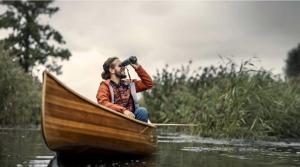Europe’s Birdwatching Boom Draws New Market Entrants
With the global birdwatching market valued at approximately €58.2 billion in 2024, the sector is experiencing significant momentum. The growing interest in wildlife observation, attracting both experienced professionals and hobbyists, opens new possibilities for optics manufacturers.
Europe alone is projected to generate €28.5 billion in birdwatching tourism revenue by 2030, with a compound annual growth rate of 5.9% from 2025. Last year, the region already accounted for 34.9% of global revenue, with the United Kingdom, the Netherlands, and Germany leading the way.
A recent study by Research Allied reveals that the largest user groups in global nature observation include professional photographers (28%), ecologists and researchers (27%), and tourists (20%). Meanwhile, millennials are becoming increasingly active in the space, driven by heightened awareness of sustainability and the importance of biodiversity conservation.
New business direction worth a try
As interest in wildlife deepens, one segment stands out for its rapid rise—wildlife spotting and conservation within the thermal imaging and night vision devices niche. The global night vision optics market size is estimated to be €8.2 billion in 2025 and is expected to grow at a robust rate, reaching €12 billion by 2030.
This surge is fueled by the need of conservation organizations and research institutions for discreet, non-invasive population monitoring, as well as technological advancements that make observation more effective and less disruptive.
Nature enthusiasts often face challenges in spotting animals and birds, especially in low-visibility environments such as dense forests or nighttime settings. Traditional observation methods can be limiting, leading to missed sightings and incomplete data collection in wildlife studies.
In this evolving landscape, Yukon Group, a European high-tech company known for its Pulsar brand of multispectral optical solutions, is launching Pulsar Wildlife. This entry presents a selection of thermal imaging and night vision devices, specifically designed for birdwatchers, nature enthusiasts, and environmentalists.
“Thermal imagers are becoming an increasingly important tool for outdoor enthusiasts, ornithologists, and ecologists. They allow you to observe animals and birds in various natural conditions—at night, in tall grass, or dense forests, when the animal is audible but not visible to the naked eye. Our decision to enter the nature monitoring segment is a natural step that reflects both our technological strengths and our commitments to environmental awareness,” says Volha Alsheuskaya, CEO of Yukon Group.
Thermal imagers for advanced data collection
As the first step, Pulsar Wildlife is introducing three lines of thermal imaging devices already recognized on the market: the Axion Compact monocular, the first sustainably renewable Telos monocular, and the Merger thermal imaging binoculars, designed for long-term observation. The company plans to expand its portfolio in 2026.
“Thermal imagers are becoming an important tool for advanced users, who usually already use daytime binoculars, specialized apps, and choose a thermal imager as a solution for the most complex tasks: nocturnal bird watching, expeditions, or searching for rare species. For researchers and conservationists, thermal imaging provides invaluable support for collecting more accurate population data, tracking migration patterns, or identifying birds that nest in dense foliage,” explains Irma Pakutinskienė, product manager at Pulsar Wildlife.
With this in mind, the Pulsar Wildlife product portfolio comprises devices that cater to the needs of advanced users, featuring a wide field of view and high-quality audio and video recording capabilities, which are particularly relevant for environmentalists studying species.
Pulsar Wildlife will initially launch in four key European markets—Finland, the United Kingdom, Belgium, and the Netherlands—countries with strong birdwatching communities, a culture of nature observation, and favorable conditions for introducing advanced technological solutions.
About Yukon Group
Yukon Group is a leading Northern European hub for thermal imaging technology, known for developing and designing Pulsar-branded products that are exported to over 70 countries worldwide. Around 90% of Pulsar devices are distributed across the United States and Europe. The Group’s manufacturing operations are based in Lithuania, Latvia, and the United Kingdom.
Germanas Kavalskis
Yukon Group
g.kavalskis@yukonww.com
Legal Disclaimer:
EIN Presswire provides this news content "as is" without warranty of any kind. We do not accept any responsibility or liability for the accuracy, content, images, videos, licenses, completeness, legality, or reliability of the information contained in this article. If you have any complaints or copyright issues related to this article, kindly contact the author above.
NEW BOOK PUTS SPOTLIGHT ON CARING FOR DEMENTIA CAREGIVERS
Pure Visibility, Inc. Launches Marketing Recharge to Spark Connection in Ann Arbor’s Marketing Scene
From Dutch Costumes to Cacti: Award-Winning Picture Book Explores Mexican-American Roots in 'Where Nopalitos Grow'
Kalendarium
Więcej ważnych informacji
 Jedynka Newserii
Jedynka Newserii

 Jedynka Newserii
Jedynka Newserii

Handel

Ważą się losy nowej umowy między Unią Europejską a Ukrainą na temat zasad handlu. Obecne przepisy wygasają 5 czerwca
5 czerwca wygasa ATM, czyli wprowadzona przed trzema laty i potem z modyfikacjami przedłużana umowa między UE a Ukrainą, liberalizująca zasady wwozu ukraińskich towarów na teren Wspólnoty. Strona ukraińska chciałaby jej przedłużenia, na razie jednak Unia zgodziła się jedynie na przedłużenie bezcłowego przywozu żelaza i stali. Największe obawy, zwłaszcza w Polsce, budzi kwestia produktów rolnych. Zdaniem europosłanki Konfederacji Anny Bryłki należałoby wrócić do obowiązującej przed 2022 rokiem umowy stowarzyszeniowej DCFTA, ponieważ Ukraina może dziś eksportować swoje towary drogą morską poprzez porty na Morzu Czarnym, a dzięki darmowemu dostępowi do unijnego rynku bogacą się jedynie potentaci rolni.
Ochrona środowiska
Nowe technologie pomagają szybciej i dokładniej sortować odpady. Wciąż nie wszystkie da się jednak przetworzyć

Do 2030 roku 55 proc. odpadów opakowaniowych z tworzyw sztucznych powinno trafiać do przetworzenia. W ubiegłym roku było to ok. 27 proc. Nowe technologie w coraz większym stopniu ułatwiają sortowanie odpadów, ale nie pozwalają jeszcze na przetworzenie wszystkich ich rodzajów. To pierwsze wyzwanie związane z zamykaniem obiegu. Kolejnym jest zwiększanie zawartości materiałów pochodzących z recyklingu w produkowanych opakowaniach, czego wymagają unijne przepisy. Choć w tym obszarze widać w ostatnich latach znaczące postępy, nie brakuje wyzwań.
Handel
Rosyjskie surowce przestaną płynąć do UE. Spóźniony, ale ambitny i istotny plan ma być wdrożony do 2027 roku

– Kupowanie surowców energetycznych z Rosji jest jak kupowanie broni przeciwko Ukrainie – uważa europosłanka PO Mirosława Nykiel. Dlatego KE planuje do 2027 roku ograniczyć do zera import rosyjskich paliw. Joanna Scheuring-Wielgus ocenia, że taka decyzja powinna zapaść już dawno, ale lepiej późno niż wcale. Co więcej, państwa członkowskie powinny być w tych deklaracjach zjednoczone najbardziej, jak się da.
Partner serwisu
Szkolenia

Akademia Newserii
Akademia Newserii to projekt, w ramach którego najlepsi polscy dziennikarze biznesowi, giełdowi oraz lifestylowi, a także szkoleniowcy z wieloletnim doświadczeniem dzielą się swoją wiedzą nt. pracy z mediami.










.gif)

 |
| |
| |
|